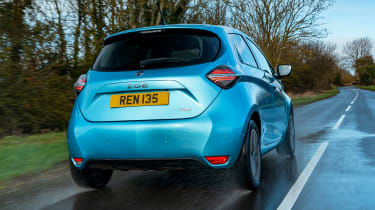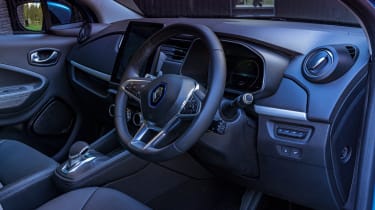New Renault Zoe 2020 review
The latest version of all-electric Renault Zoe supermini raises its game again

Verdict
The Zoe continues to lead the way in the small, affordable electric car segment. It’s cheaper than the Nissan Leaf, more practical than the Vauxhall Corsa-e, and delivers more range than either of them. There’s no denying that it’s a tidy-looking thing, too. It’s a shame that CCS fast-charging is a pricey optional extra, but you’ll struggle to find a small electric car that makes as much sense as this one.
The new Renault Zoe follows a simple philosophy: the same as before, but more of it. More battery capacity, more range and more technology. And this is our first chance to test the new model in the UK.
The Zoe is available with two outputs from its single, front-mounted electric motor: an R110 model with 107bhp or an R135 version with 134bhp. We’re driving the latter, which means 0-62mph in 9.5 seconds and a top speed of 87mph. And its new 52kWh battery also means a theoretical range of 238 miles.
From the driver’s seat, the Zoe feels fast enough everywhere, from around town to the motorway, although performance drops noticeably in range-maximising Eco mode. This setting also features a pressure-step in the throttle that prevents you from using full power unless you absolutely need it.
The car is nippy in a straight line, but that speed doesn’t translate into cornering ability. There’s very little feel through the steering – which is otherwise well weighted – and the body leans a fair bit in slow, sharp turns. This isn’t helped by the seat, which offers little in the way of support and can’t be adjusted for height. If you were hoping the Zoe would put a smile on your face occasionally, you’ll likely be disappointed. Ride comfort is fairly typical for the class: firmer that you’d like but not overly uncomfortable.
Used - available now

2024 Audi
A3 Sportback
50,864 milesAutomaticPetrol1.4L
Cash £23,497
2018 Peugeot
3008
35,735 milesManualDiesel1.6L
Cash £11,799
2022 BMW
X1
46,610 milesAutomaticPetrol2.0L
Cash £19,697
2023 Ford
Fiesta
12,239 milesManualPetrol1.0L
Cash £14,397Our UK test route covered a mix of roads, and despite the cold conditions, we still saw energy consumption of 3.5 miles/kWh, despite making no real effort to be gentle on the throttle. This translates into a theoretical range of 182 miles; well down on the 238 miles promised in this top-spec, GT Line car, but no more so than you’d expect at this time of year. Perhaps it would be better if the regenerative braking system was more effective: even in its strongest ‘B’ mode, it’s not enough to achieve the ‘one-pedal’ driving offered in some rivals.
The charging socket is located in the nose under the car’s badge. As standard this is a Type 2 plug capable of up to 22kW on an AC connection, at which rate a full top-up will take three hours. At the other end of the scale, a 7.4kW home wallbox will take just over nine hours. Frustratingly, DC charging via a CCS port is only available as a £750 option on mid- and top-spec cars. This sees an 80 per cent charge delivered in 70 minutes.
Inside, the interior borrows heavily from the latest Clio and Captur, making use of soft-touch plastics along the dashboard. The standard set-up features a 10-inch digital display combined with a seven-inch infotainment screen using Renault’s EasyLink system, although GT Line cars see this upgraded to a 9.3-inch portrait device.
The graphics are sharp and the interface is reasonably responsive, although the menu layout isn’t as intuitive as we’d like. Luckily, Apple CarPlay and Android Auto are standard across the line-up.
Front passengers will be comfortable enough, although head and legroom for average-sized adults in the rear is in short supply. The boot measures 338 litres, and while this is more than you get in most rivals, you only get a split-folding rear bench on mid-spec Iconic cars and above. Plus, there is no compartment to store charging cables, unless you pay £155 for a false boot floor.
Prices start from £26,170 for the entry-level Play model, mid-spec Iconic cars cost from £27,670, and the range tops out at £29,120 for GT Line cars. Here, you get tinted rear windows, 16-inch, diamond-cut alloys, front parking sensors, a reversing camera, blind-spot warning, an auto-dimming rear-view mirror and electric door mirrors.
With annual mileage capped at 10,000, the entry-level model is available on finance for £269 per month over three years, following an initial deposit of £3,000. This rises to £313 and £321 a month for the Iconic R135 and GT Line models. Of the Zoe’s main rivals, only the Nissan Leaf is anywhere near that affordable, making the Renault a compelling option with its range advantage over the competition.
| Model: | Renault Zoe R135 Z.E. 50 GT Line |
| Price: | £28,620 (incl Govt grant) |
| Engine: | Single electric motor, 52kWh battery |
| Power/torque: | 134bhp/245Nm |
| Transmission: | Single-speed auto, front-wheel drive |
| 0-62mph: | 9.5 seconds |
| Top speed: | 87mph |
| Range: | 238 miles |
| CO2: | 0g/km |
| On sale: | Now |









